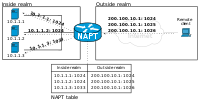Port forwarding

Imagine you have a toy house with different rooms, and you want your friends to come and play in specific rooms. However, to enter the house, they have to go through the main door. But if you want your friends to enter a specific room, you need to tell them which room to go to, right?
Port forwarding is like telling your friends which room to go to. In the same way, a computer has different "rooms" called ports. Ports are like doors in a house, and each door (or port) leads to a different program or service on the computer.
When your computer tries to communicate with another computer or device, it needs to know which port to use to reach the right program or service. Port forwarding allows you to tell your internet router which port your computer is using and where it should send incoming requests.
So, if you host a Minecraft server on your computer, you need to tell your router to forward incoming requests on port 25565 (the default Minecraft port) to your computer. This way, when someone wants to join your Minecraft game, their request is sent to your computer, and they are placed in the same room (port) as the Minecraft server.
In summary, port forwarding is like giving someone directions to a specific room in your toy house, but instead, it is your computer giving directions to incoming requests on which port to go to.
Port forwarding is like telling your friends which room to go to. In the same way, a computer has different "rooms" called ports. Ports are like doors in a house, and each door (or port) leads to a different program or service on the computer.
When your computer tries to communicate with another computer or device, it needs to know which port to use to reach the right program or service. Port forwarding allows you to tell your internet router which port your computer is using and where it should send incoming requests.
So, if you host a Minecraft server on your computer, you need to tell your router to forward incoming requests on port 25565 (the default Minecraft port) to your computer. This way, when someone wants to join your Minecraft game, their request is sent to your computer, and they are placed in the same room (port) as the Minecraft server.
In summary, port forwarding is like giving someone directions to a specific room in your toy house, but instead, it is your computer giving directions to incoming requests on which port to go to.
Related topics others have asked about:
